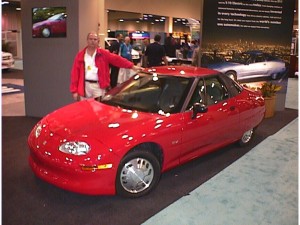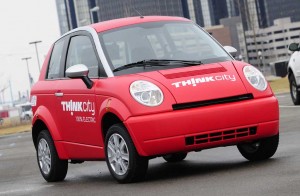When the Norwegian electric vehicle maker, Think, started looking for a site to build a U.S. assembly plant, it was deluged by offers from states and communities lined up coast-to-coast. In the end, it chose the Northern Indiana town of Elkhart for the plant, which will begin rolling out a version of the Think City two-seater next year.
These days, any deal that can deliver jobs and investments is likely to be greeted with gusto – and the offer of government assistance, and the Think project was no exception. In the end, state and local officials cobbled together a package of assistance worth $43 million for the battery car maker.
That certainly didn’t hurt, admits Think CEO Richard Canny, not for a long-struggling company that had just emerged, a few months earlier, from bankruptcy proection. But even with what he describes as a “competitive” package of incentives, the executive says that wasn’t the clincher when it came to choosing Elkhart. “You don’t choose a location just based on incentives,” Canny explains.
What sold Think was the fact that Elkhart had a pool of experienced labor – workers who were more than happy to get a good-paying job considering that the region’s traditional manufacturing base, the recreational vehicle, or RV, industry, has all but collapsed – along with an existing battery car infrastructure.
+

The General Motors EV1, a version of which is seen here, was developed at a skunkworks facility in Indianapolis, Indiana.
In the early days of the auto industry, Indiana gave a serious challenge to Michigan as the home of the American industry. Eventually, the Hoosier State’s neighbor to the north won out. But these days, if Detroit likes to bill itself as the Motor City, Indiana is on its way to becoming EV Central.
“Indiana is becoming more and more of a Silicon Valley,” at least when it comes to tomorrow’s high-tech battery car technology,” suggests Rick Stanley, the president of Indianapolis-based EnerDel, currently the only large-scale producer of lithium-ion batteries in the United States.
President Barack Obama lent credence to that position, last August, when he came to Indiana to announce the first 48 advanced battery electric vehicle projects to receive $2.4 billion in funding under the American Recovery and Reinvestment Act. To date, EnerDel and other businesses located in the Midwest state have been granted more than $500 million of that assistance, and they could be in for even more, going forward.
As Think’s Canny realized, it helps to have a well-established network of automotive suppliers in Indiana, a significant number of them already providing research and technology for battery powertrains.
Indeed, a small skunkworks operation, on the outskirts of Indianapolis, was where General Motors did the initial development work for its well-publicized EV1 battery car program, back in the 1990s. Many of its key components, meanwhile, came from former GM partsmaking operations, like Delco-Remy.
In recent years, GM has spun off many of those subsidiaries, but they’ve remained in Indiana. The list includes the likes of Allison Transmission, whih produces key components for hybrid and electric buses and automobiles, as well as Delphi, which provides electrical and electronic systems from its Indiana oprations. In its current form, Remy builds electric motors and hybrid transmission components.
There is a lot of “intellectual horsepower” when it comes to battery car technology, suggests Paul Mitchell, Pres & CEO, Energy Systems Network, or ESN, an organization designed to promote the development of alternative energy businesses in Indiana.
For his part, Governor Mitch Daniels has made battery car technology one of his primary targets for development, promoting Indiana as “the electric vehicle state.”
Though there’s an ongoing debate over just how much the market will embrace battery propulsion, few would disagree with the Governor’s view that, “This may well be the defining new technology in transportation.” In an interview with the Indiana Economic Digest, Daniels described the state’s increasing role in the growth of the new technology as, “a huge positive, a huge moment for our state.”
Along with Think, Indiana has also attracted some smaller battery car start-ups, such as Bright Automotive, which has landed a large contract to provide vehicles to the U.S. Postal Service.
But the Hoosiers don’t have a lock on the technology, by any means, cautions David Cole, director of the Center for Automotive Research, (CAR), in Ann Arbor, Michigan.
“I don’t know a state that isn’t aggressively trying to get into this business,” Cole asserts, noting that Michigan is home to much of the battery car work underway at the U.S. Big Three, including the Chevrolet Volt plug-in hybrid and the Ford Transit Connect battery van, both of which will go into production late this year.
California, which is likely to become the nation’s largest battery car market, also has some of the largest independent battery car suppliers, such as Tesla Motors, a Silicon Valley start-up currently producing high-performance battery cars, and Fisker Automotive, which is getting ready to launch a sleek plug-in hybrid sports coupe. Fisker, meanwhile, has used a federal loan package to acquire an old GM plant, in Delaware, where it will start building a higher-volume model, dubbed Project Nina, several years from now.
Nonetheless, says CAR’s Cole, “Indiana is generally attractive,” and when you combines its workforce, its supply and research base, and a willingness to provide cash to lure in potential employers, the Hoosier State seems well poised to succeed in the rollut of the battery-powered auto industry.

